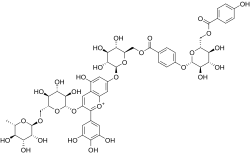Violdelphin
Names
IUPAC name
3′,4′,5,5′-Tetrahydroxy-7-(6-O -{4-[6-O -(4-hydroxybenzoyl)-β-D -glucopyranosyloxy]benzoyl}-β-D -glucopyranosyloxy)-3-[α-L -rhamnopyranosyl-(1→6)-β-D -glucopyranosyloxy]flavylium
Systematic IUPAC name
(12 R ,13 R ,14 R ,15 R ,16 S ,42 R ,43 S ,44 S ,45 R ,46 S ,82 S ,83 R ,84 S ,85 S ,86 R ,142 S ,143 R ,144 S ,145 S ,146 R )-13 ,14 ,15 ,43 ,44 ,45 ,65 ,83 ,84 ,85 ,143 ,144 ,145 ,184 -Tetradecahydroxy-16 -methyl-11,17-dioxo-62 -(3,4,5-trihydroxyphenyl)-2,5,7,10,13,16-hexaoxa-61 λ4 -6(3,7)-[1]benzopyrana-1(2),4,8,14(2,6)-tetrakis(oxana)-12(1,4),18(1)-dibenzenaoctadecaphan-61 -ylium
Other names
Delphinidin 3-rutinoside-7-O-(6-O-(4-(6-O-(4-hydroxybenzoyl)-beta-D-glucosyl)oxybenzoyl)-beta-D-glucoside)
Identifiers
ChemSpider
InChI=1S/C53H58O30/c1-18-34(58)39(63)43(67)50(76-18)75-17-33-38(62)42(66)46(70)53(83-33)80-30-14-25-26(55)12-24(13-29(25)79-47(30)21-10-27(56)35(59)28(57)11-21)78-52-45(69)41(65)37(61)32(82-52)16-74-49(72)20-4-8-23(9-5-20)77-51-44(68)40(64)36(60)31(81-51)15-73-48(71)19-2-6-22(54)7-3-19/h2-14,18,31-34,36-46,50-53,58,60-70H,15-17H2,1H3,(H4-,54,55,56,57,59,71)/p+1/t18-,31+,32+,33+,34-,36+,37+,38+,39+,40-,41-,42-,43+,44+,45+,46+,50+,51+,52+,53+/m0/s1
Key: YODABPUZPVYDEF-CIBWSIAMSA-O
CC1C(C(C(C(O1)OCC2C(C(C(C(O2)OC3=C([O+]=C4C=C(C=C(C4=C3)O)OC5C(C(C(C(O5)COC(=O)C6=CC=C(C=C6)OC7C(C(C(C(O7)COC(=O)C8=CC=C(C=C8)O)O)O)O)O)O)O)C9=CC(=C(C(=C9)O)O)O)O)O)O)O)O)O
Properties
C53 H59 O30 +
Molar mass
1176.02 g/mol
Except where otherwise noted, data are given for materials in their
standard state (at 25 °C [77 °F], 100 kPa).
Chemical compound
Violdelphin is an anthocyanin , a plant pigment, has been found in the purplish blue flower of Aconitum chinense [ 1] Campanula [ 2] Delphinium hybridum [ 3] p-hydroxy benzoic acid residues, one rutinoside and two glucosides associated with a delphinidin .
References
^ The anthocyanin responsible for purplish blue flower colour of Aconitum chinense. Kosaku Takeda, Syuji Sato, Hiromitsu Kobayashi, Yoko Kanaitsuka, Mariko Ueno, Takeshi Kinoshita, Hiroyuki Tazaki and Takane Fujimori, Phytochemistry, June 1994, Volume 36, Issue 3, Pages 613–616, doi :10.1016/S0031-9422(00)89784-8
^ Structure and biosynthesis of anthocyanins in flowers of Campanula. Kirsten Brandt, Tadao Kondo, Hideki Aoki and Toshio Goto, Phytochemistry, 29 April 1993, Volume 33, Issue 1, Pages 209–212, doi :10.1016/0031-9422(93)85424-P
^ Structure of Violdelphin, an Anthocyanin from Violet Flower of Delphinium hybridum. Tadao Kondo, Kaori Oki, Kumi Yoshida and Toshio Goto, Chemistry Letters,1990, Vol. 19, No. 1, pages 137-138, doi :10.1246/cl.1990.137
3-Hydroxyanthocyanidins 3-Deoxyanthocyanidins O -Methylated anthocyanidinsAnthocyanins Glucosides:
Diglucosides:
Others glycosides:
Acylated anthocyanins
Acetylated anthocyaninsCoumaroylated anthocyaninscis - and trans -) Caffeoylated anthocyanins Malonylated anthocyanins Acylated anthocyanin diglycosides
Flavanol-anthocyanin adducts Miscellaneous
